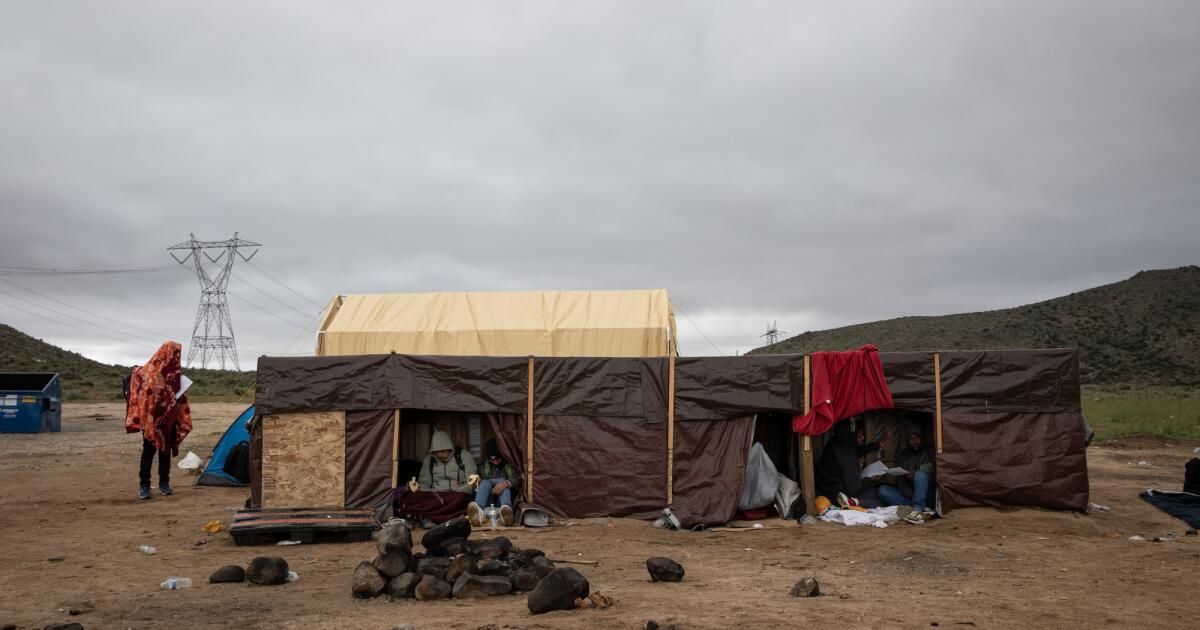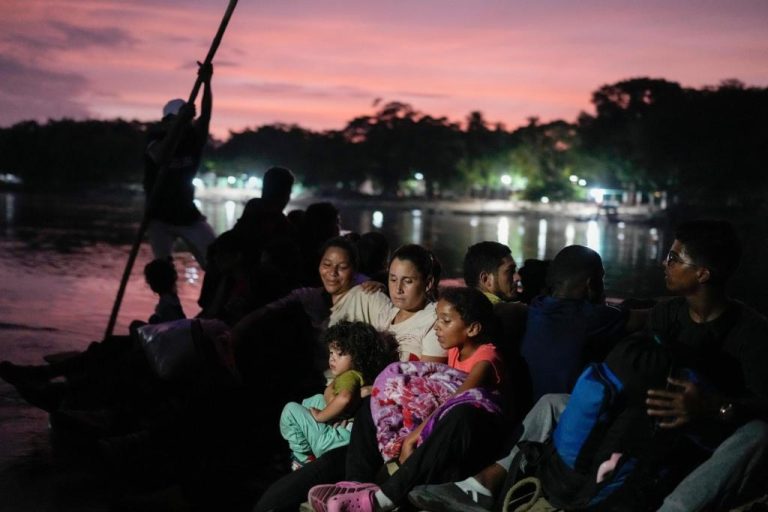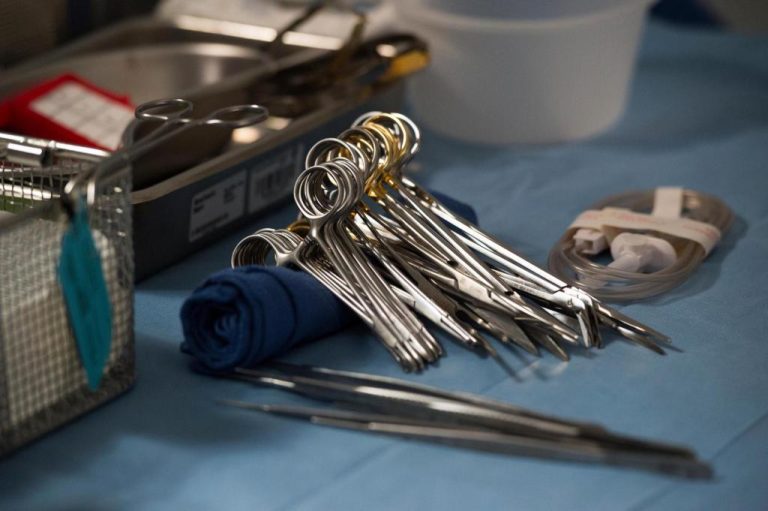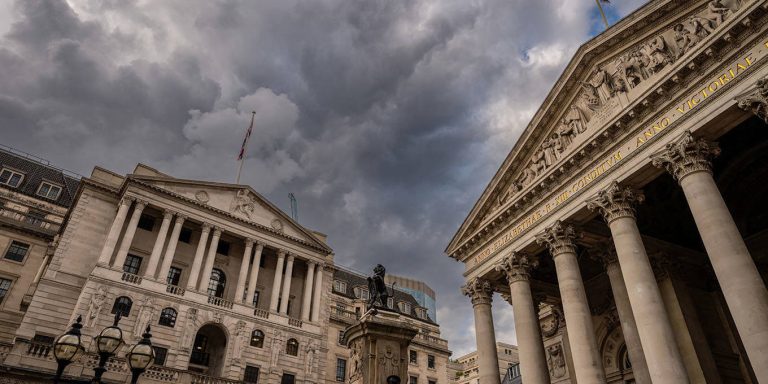
Late last month, a demolition crew contracted by the federal government demolished the shelters that volunteers had built at a migrant camp just off Interstate 8 near Jacumba Hot Springs, one of the Border Patrol’s unofficial and otherwise open-air detention centers along the San Diego County-Mexico border.
Not to be deterred in their efforts to help protect the migrants and asylum seekers who cycle through the camps, the volunteers quickly rebuilt another shelter. They once again used pallets, tarps and other materials that, through trial and error, they’d found to be effective against the whipping winds and harsh conditions of the high desert.
Demolition crews on Feb. 28 used heavy machinery to tear down shelters that volunteers had built for migrants and asylum seekers at a camp just off Interstate 8 near Jacumba Hot Springs. The camp is one of several unofficial open-air detention sites where Border Patrol agents hold asylum seekers who have surrendered and are waiting to be processed. (Courtesy of John Schultz)
But just two days after the new shelter was erected, a small group of young men, some of them possibly teens, showed up at the camp and vandalized the structure, tearing the outer tarp covering and ripping off the battens that helped secure the tarps, according to a volunteer who confronted and photographed the group and the damage they caused. He said the group also vandalized infrastructure installed by government contractors, breaking hoses and pipes on a water tank and pushing over portable toilets.
“It’s not very comforting to know this can happen,” John Schultz, one of the volunteers who confronted the group, said.
The incident was one of the latest examples of apparent anti-migrant animosity along the local border, where for seven months large groups of asylum seekers have been surrendering to Border Patrol agents and then awaiting processing at the unofficial open-air detention sites. Concern about such hostility is ever present among migrant advocates, especially since the camps sprouted up in large numbers last September, but it’s especially heightened this year during the presidential election and in the wake of recent tensions along the Texas border, where a conflict between state and federal authorities recently whipped up highly publicized anti-migrant demonstrations.

Volunteers handed out water and sandwiches Friday to more than 60 migrants and asylum seekers who arrived to a camp just off of Interstate 8 near Jacumba Hot Springs. The large group included families with children and was made up of people from all over the world, including Pakistan, Brazil, Dominican Republic, Bolivia, Honduras, Egypt and Somalia.
(Ana Ramirez/The San Diego Union-Tribune)
“Everybody feels like there is definitely a real risk,” said Dr. David Greenblatt, a surgeon with Sharp Rees-Stealy medical group who in his personal time is involved in various on-the-ground volunteer efforts to help local migrants, including the Borderlands Relief Collective.
“It’s just a matter of time before a migrant or volunteer is injured, or worse,” Greenblatt predicted.
He said there has been “a steady stream” of agitators at the local sites since the area became a major crossing spot late last summer. He said often times they are YouTubers or social media personalities who “confront volunteers and film close up in migrants’ faces.” On one occasion last October, when several young people repeatedly drove dangerously through a camp in Boulevard, one of the drivers allegedly ran over the foot of a Turkish migrant.
Schultz said no migrants were present at the camp off Interstate 8, situated near Valley of the Moon, when the group vandalized the shelter.
The latest incidents at the camp began Feb. 28, when a demolition crew operating heavy machinery tore apart the previous shelters that volunteers had built, according to photos and videos provided by Schultz. The site had once been dotted with bright pink tents — activists had upcycled camping tents discarded by the breast-cancer organization Susan G. Komen for the Cure — but those and other tents had been unable to withstand the area’s powerful winds for more than a few days at a time.
“The winds are really aggressive there,” Schultz said. He and the other volunteers tried several different types of construction styles before finding one that held up against the winds and the cold winter temperatures, which often produced icy overnight conditions.
“Those shelters were vital … We were very proud of them,” Schultz said. “Everyone was using them. Those shelters were always full.”
Then came the demolition crew.
The Border Patrol declined to comment on the reasons behind the demolition. Volunteers said it’s not the first time such crews have destroyed shelters and cleaned out an open-air detention site in such a manner.

A day after crews tore down shelters at a migrant encampment near Jacumba Hot Springs, John Schultz and other volunteers built a new shelter, seen here under construction.
(Courtesy of John Schultz)
Two days after the camp was cleared out, Gov. Gavin Newsom visited the San Diego County-Mexico border, including the fence in the Jacumba area, according to his office. It’s unclear if he passed by or visited the site near Valley of the Moon, but by that time Schultz and other volunteers had already rebuilt a shelter.
“They can tear them down, but we’ll just rebuild them,” said Schultz, who cited his Quaker faith as the main motivation behind his and his family’s volunteerism.
Two days after the volunteers had rebuilt the shelter, Schultz’s mother drove by the camp and noticed a small group of people there. At first, she thought they were from another volunteer group that sometimes helps in the area. But then she noticed one of the individuals was tearing apart the shelter with a hammer.

Volunteers said vandals ripped and ransacked a newly built shelter for migrants and asylum seekers at an encampment near Valley of the Moon.
(Courtesy of John Schultz)
Notified of what was happening, Schultz quickly made his way to the camp. “I immediately confronted them, asked them what the hell they were doing and told them they were heartless,” Schultz recalled. He said the group appeared to be made up of young men, some of them possibly teenagers. One identified himself as a minor several times. One kept asking Schultz if the shelters were properly permitted.
Schultz informed the group that a water tank they had vandalized by breaking its pipes and the portable toilets that they pushed over “were not from us volunteers — those were subcontracted by the Border Patrol and they had damaged private property.”

Vandals earlier this month allegedly knocked over portable toilets that were set up by government contractors at a migrant encampment near Jacumba Hot Springs.
(Courtesy of John Schultz)

Vandals damaged a water tank set up at a migrant camp near Jacumba Hot Springs. The tank has since been fixed. A CBP spokesperson said the agency is aware of the recent incident and does not tolerate such tampering.
(Courtesy of John Schultz)
Schultz said that volunteers reported the incident to a Border Patrol agent, sending him photos of the people involved in the vandalism and their vehicles, including their license plate numbers. He said the agent told him that the information would get passed up the chain, but the volunteers had heard nothing further from Border Patrol since then.
“(Customs and Border Protection) does not tolerate tampering with, or the vandalism of, its property, facilities, or infrastructure,” a spokesperson from Customs and Border Protection, Border Patrol’s parent agency, told the Union-Tribune in a statement. “The U.S. Border Patrol, San Diego Sector is aware of recent vandalism to contractually placed humanitarian resources near Jacumba Hot Springs and is taking appropriate action to identify the source of the vandalism and to prevent future acts of vandalism.”
Schultz also said his father reported the incident to the Sheriff’s Department. A sheriff’s spokesperson said Thursday that the department had “not received any reports or calls for service related to the incident in question.”
While the recent vandalism at the camp highlighted concerns about the potential for anti-migrant harassment or violence, migrant-rights groups continue to sound the alarm about the poor conditions at the open-air detention sites. On Friday, the Center for Gender & Refugee Studies and the migrant-justice law group Al Otro Lado filed a Freedom of Information Act lawsuit in federal court in San Francisco in an attempt to compel CBP to release information about its policies and practices at the camps.
“People held in CBP’s open air detention sites have suffered grave human rights violations,” Edith Sangüeza, staff attorney at the Center for Gender & Refugee Studies, said in a statement. “… The agency cannot keep sidestepping accountability. People seeking safety deserve answers, as do the humanitarian aid groups that have stepped in where the government has failed to protect lives.”

Border Patrol agents wait for an ambulance to arrive after a man collapsed Friday at an open-air detention site near Jacumba Hot Springs. One of the agents called for the ambulance.
(Ana Ramirez/The San Diego Union-Tribune)

Emergency crews took the man, who was unresponsive, to a waiting ambulance. A friend said the man was Egyptian and had not eaten in several days.
(Ana Ramirez/The San Diego Union-Tribune)
On Friday, the Union-Tribune witnessed an Egyptian migrant collapse and become unresponsive at the site near Valley of the Moon. He was later taken away in an ambulance. A Cal Fire San Diego spokesperson did not know his condition, but said he was unconscious but breathing when he was taken to a hospital.
Staff photojournalist Ana Ramirez contributed to this report.








